Page 293 of 425
In case of emergency
9-2
If you park your vehicle in case of an emergency
The hazard warning flasher should be used in day
or night to warn other drivers when you have to parkyour vehicle under emergency conditions.
Avoid stopping on the road. It is best to safely pull
off the road if a problem occurs.
The hazard warning flasher can be activated
regardless of the ignition switch position.
Turn on the hazard warning by pushing the hazard
warning flasher switch. Turn it off by pushing theswitch again.NOTE When the hazard warning flasher is on, the turn
signals do not work.
Page 295 of 425
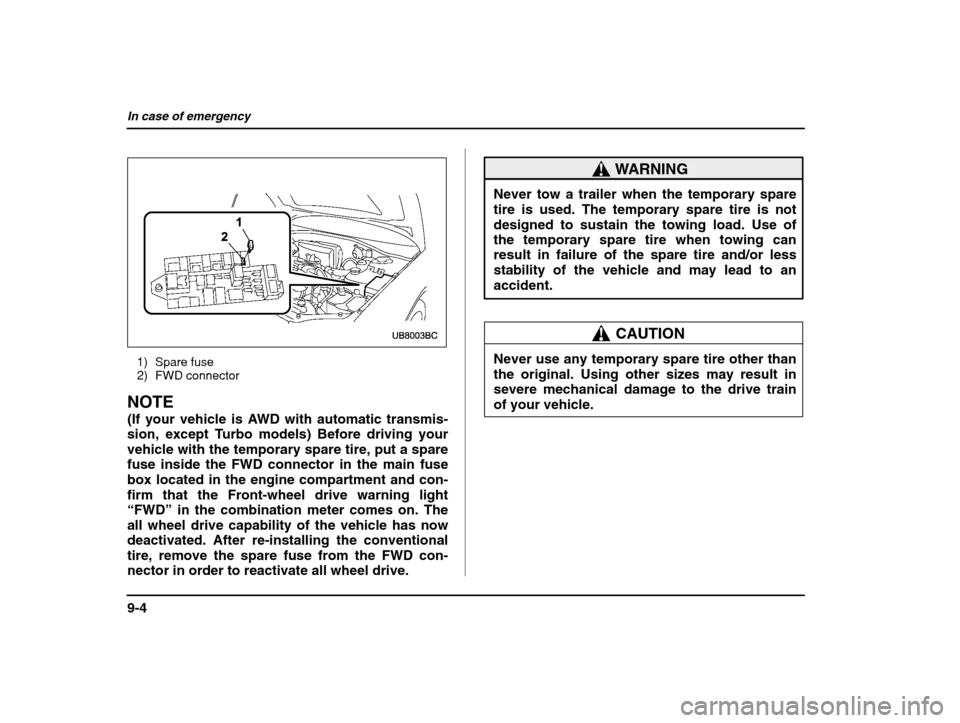
In case of emergency
9-4
1) Spare fuse
2) FWD connector
NOTE
(If your vehicle is AWD with automatic transmis-
sion, except Turbo models) Before driving your
vehicle with the temporary spare tire, put a spare fuse inside the FWD connector in the main fuse box located in the engine compartment and con-firm that the Front-wheel drive warning light
“FWD” in the combination meter comes on. The
all wheel drive capability of the vehicle has now
deactivated. After re-installing the conventional tire, remove the spare fuse from the FWD con- nector in order to reactivate all wheel drive.
WARNING
Never tow a trailer when the temporary spare tire is used. The temporary spare tire is not
designed to sustain the towing load. Use ofthe temporary spare tire when towing can result in failure of the spare tire and/or less
stability of the vehicle and may lead to anaccident.
CAUTION
Never use any temporary spare tire other than the original. Using other sizes may result in
severe mechanical damage to the drive trainof your vehicle.
Page 296 of 425
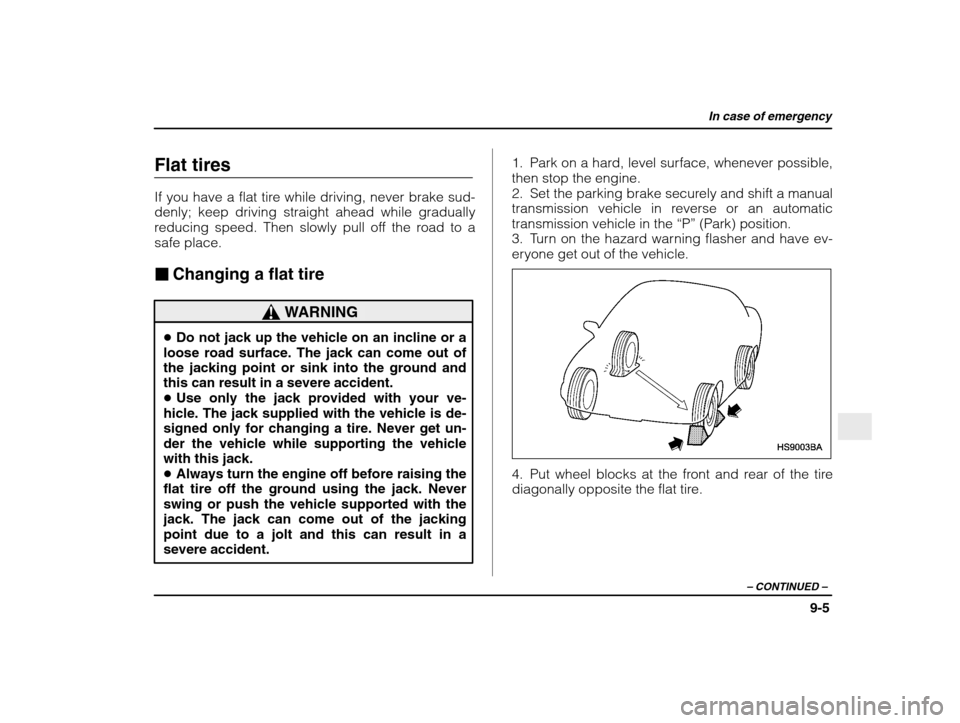
In case of emergency
9-5
– CONTINUED –
Flat tires
If you have a flat tire while driving, never brake sud- denly; keep driving straight ahead while gradually
reducing speed. Then slowly pull off the road to asafe place. �Changing a flat tire
WARNING
�Do not jack up the vehicle on an incline or a
loose road surface. The jack can come out of
the jacking point or sink into the ground and this can result in a severe accident.� Use only the jack provided with your ve-
hicle. The jack supplied with the vehicle is de-signed only for changing a tire. Never get un-der the vehicle while supporting the vehicle with this jack. � Always turn the engine off before raising the
flat tire off the ground using the jack. Neverswing or push the vehicle supported with the
jack. The jack can come out of the jackingpoint due to a jolt and this can result in a
severe accident. 1. Park on a hard, level surface, whenever possible,
then stop the engine.
2. Set the parking brake securely and shift a manual
transmission vehicle in reverse or an automatictransmission vehicle in the
“P” (Park) position.
3. Turn on the hazard warning flasher and have ev-
eryone get out of the vehicle.
4. Put wheel blocks at the front and rear of the tire
diagonally opposite the flat tire.
Page 303 of 425
In case of emergency
9-12
11. Before putting the spare tire on, clean themounting surface of the wheel and hub with a cloth.
12. Put on the spare tire. Replace the wheel nuts.
Tighten them by hand.
WARNING
Do not use oil or grease on the wheel studs or nuts when the spare tire is installed. Thiscould cause the nuts to become loose andlead to an accident.
13. Turn the jack handle counterclockwise to lowerthe vehicle.
14. Use the wheel nut wrench to securely tighten
Page 305 of 425
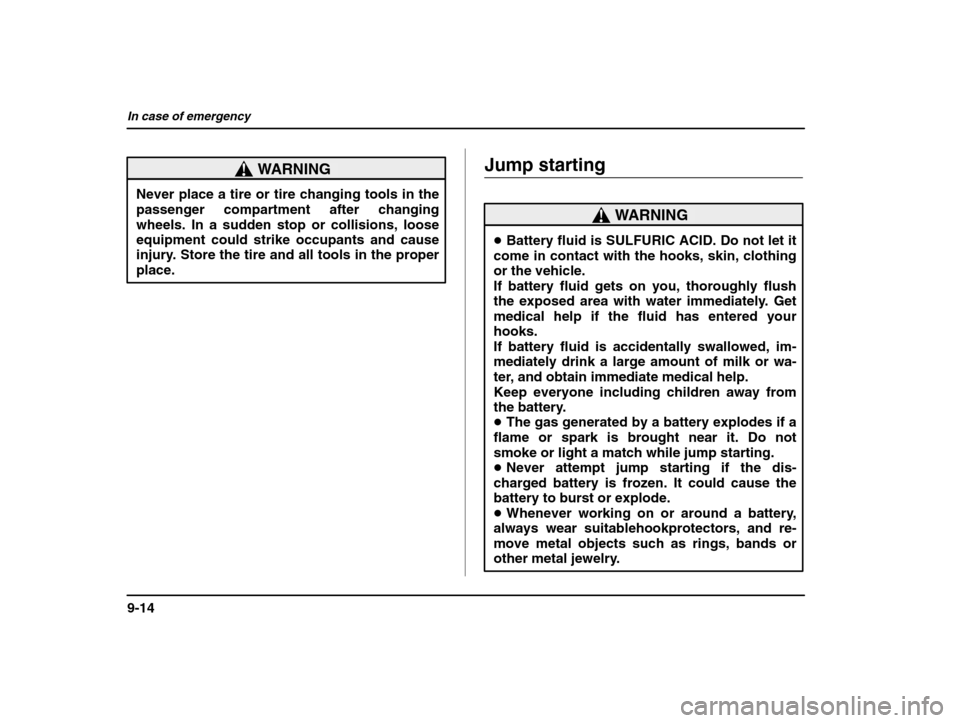
In case of emergency
9-14
WARNING
Never place a tire or tire changing tools in the
passenger compartment after changing
wheels. In a sudden stop or collisions, looseequipment could strike occupants and cause
injury. Store the tire and all tools in the proper place.Jump starting
WARNING
�
Battery fluid is SULFURIC ACID. Do not let it
come in contact with the hooks, skin, clothing or the vehicle. If battery fluid gets on you, thoroughly flush
the exposed area with water immediately. Get
medical help if the fluid has entered your hooks.
If battery fluid is accidentally swallowed, im-
mediately drink a large amount of milk or wa-
ter, and obtain immediate medical help. Keep everyone including children away from
the battery. � The gas generated by a battery explodes if a
flame or spark is brought near it. Do not
smoke or light a match while jump starting.� Never attempt jump starting if the dis-
charged battery is frozen. It could cause thebattery to burst or explode. � Whenever working on or around a battery,
always wear suitablehookprotectors, and re- move metal objects such as rings, bands or
other metal jewelry.
Page 308 of 425
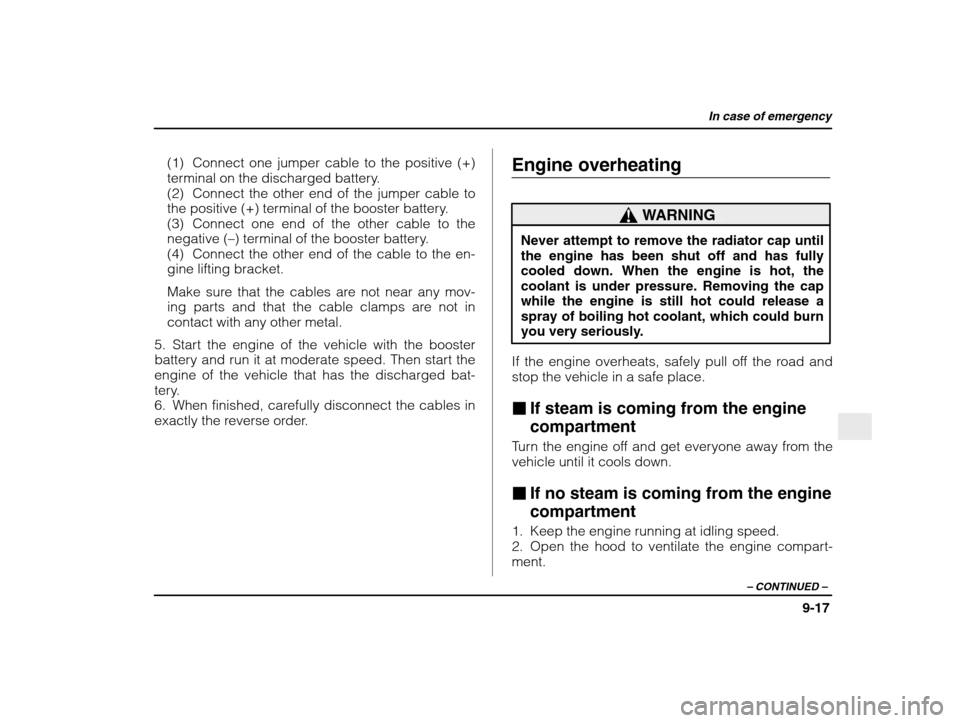
In case of emergency
9-17
– CONTINUED –
(1) Connect one jumper cable to the positive (+)
terminal on the discharged battery.
(2) Connect the other end of the jumper cable to
the positive (+) terminal of the booster battery.
(3) Connect one end of the other cable to thenegative (–) terminal of the booster battery.
(4) Connect the other end of the cable to the en-gine lifting bracket.
Make sure that the cables are not near any mov-
ing parts and that the cable clamps are not in
contact with any other metal.
5. Start the engine of the vehicle with the booster
battery and run it at moderate speed. Then start the
engine of the vehicle that has the discharged bat-
tery.
6. When finished, carefully disconnect the cables in
exactly the reverse order. Engine overheating
WARNING
Never attempt to remove the radiator cap until the engine has been shut off and has fullycooled down. When the engine is hot, thecoolant is under pressure. Removing the cap
while the engine is still hot could release aspray of boiling hot coolant, which could burn
you very seriously.
If the engine overheats, safely pull off the road and stop the vehicle in a safe place. � If steam is coming from the engine compartment
Turn the engine off and get everyone away from the
vehicle until it cools down. � If no steam is coming from the engine compartment
1. Keep the engine running at idling speed.
2. Open the hood to ventilate the engine compart-ment.
Page 309 of 425
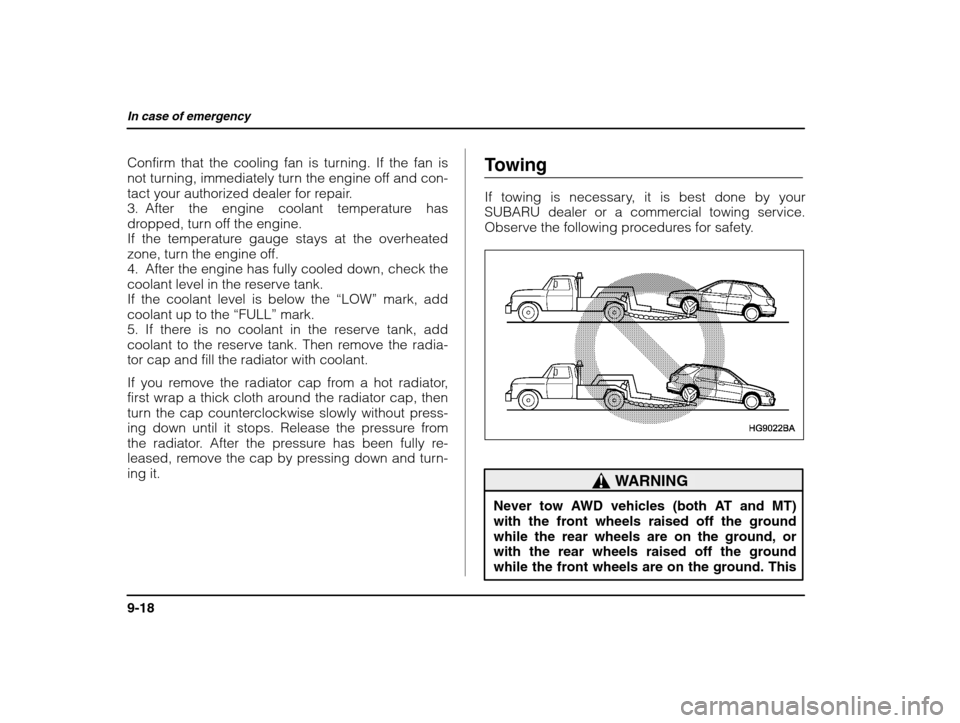
In case of emergency
9-18
Confirm that the cooling fan is turning. If the fan is
not turning, immediately turn the engine off and con-
tact your authorized dealer for repair.
3. After the engine coolant temperature has
dropped, turn off the engine.
If the temperature gauge stays at the overheated
zone, turn the engine off.
4. After the engine has fully cooled down, check the
coolant level in the reserve tank.If the coolant level is below the “LOW” mark, add
coolant up to the “FULL” mark.
5. If there is no coolant in the reserve tank, add
coolant to the reserve tank. Then remove the radia- tor cap and fill the radiator with coolant.
If you remove the radiator cap from a hot radiator,
first wrap a thick cloth around the radiator cap, then
turn the cap counterclockwise slowly without press-
ing down until it stops. Release the pressure from
the radiator. After the pressure has been fully re-
leased, remove the cap by pressing down and turn-ing it. Towing
If towing is necessary, it is best done by your
SUBARU dealer or a commercial towing service.
Observe the following procedures for safety.
WARNING
Never tow AWD vehicles (both AT and MT) with the front wheels raised off the groundwhile the rear wheels are on the ground, orwith the rear wheels raised off the groundwhile the front wheels are on the ground. This
Page 311 of 425
In case of emergency
9-20
taching the towing hook.
3. Screw the towing hook into the threaded hole un-
til its thread can no longer be seen.
4. Tighten the towing hook securely with a wheel nut
wrench.
After towing, remove the towing hook from the
vehicle and stow it in the tool bag. Put the threaded
hole cover on the front bumper.
WARNING
�Do not use the towing hook except when
towing your vehicle. � Be sure to remove the towing hook after
towing. Leaving the towing hook mounted onthe vehicle could interfere with proper opera- tion of the SRS airbag system in a frontal col- lision. Rear towing hook:
CAUTION
Do not apply excessive lateral load to the tow- ing hook.